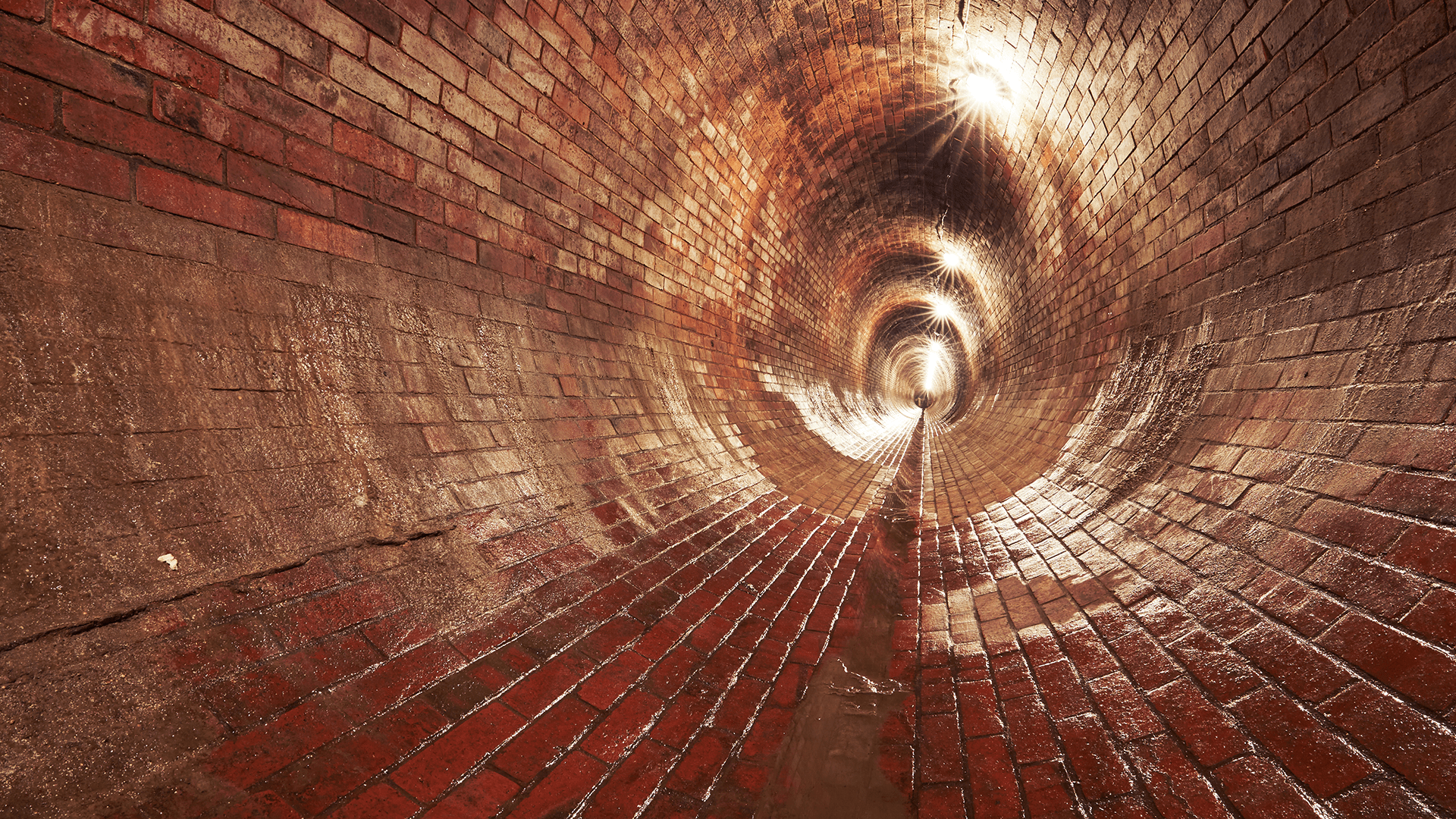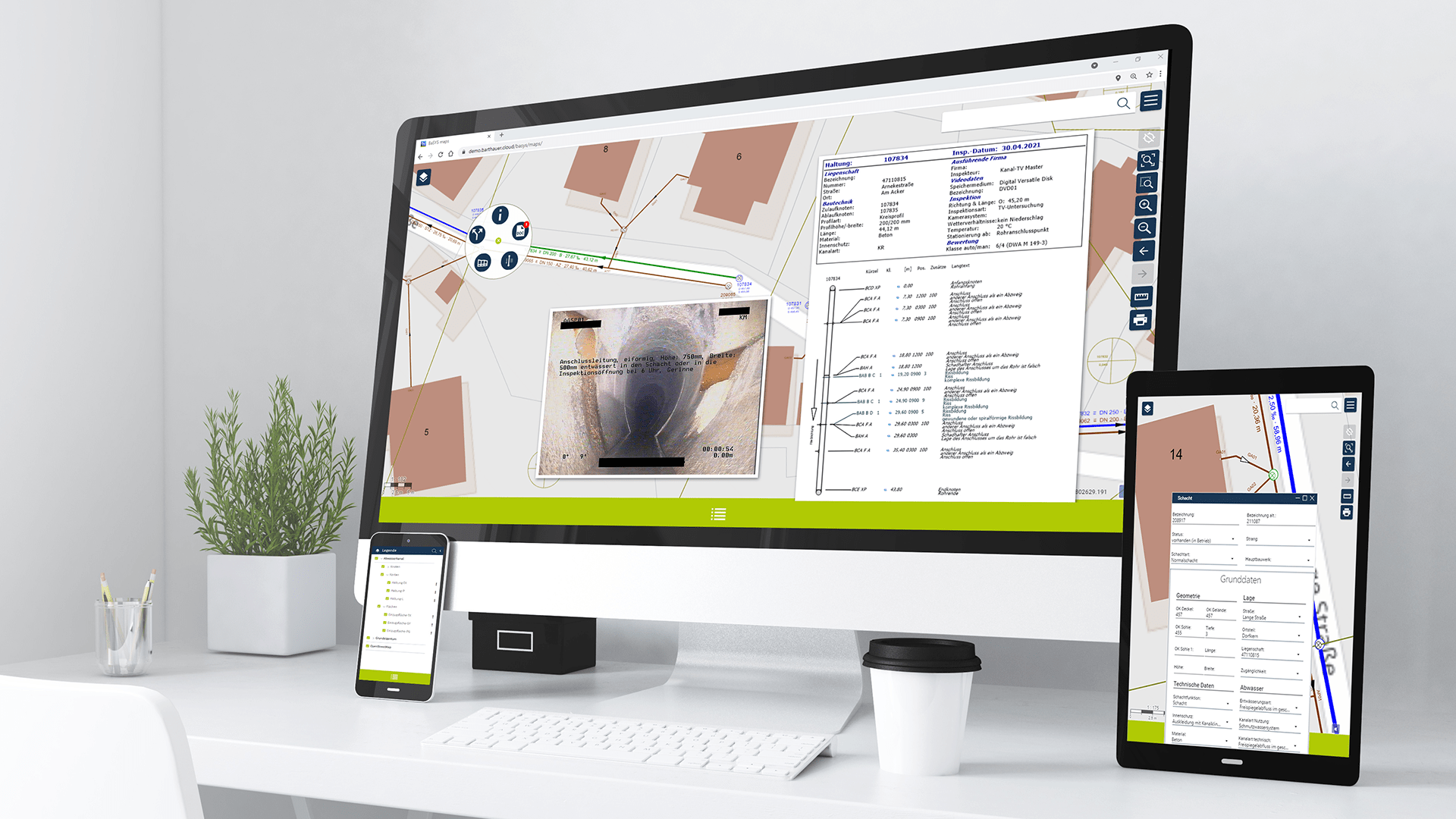Maintaining value through forward-looking network management
Who can tell you how the substance and value of your sewer network will develop over the next few years? In view of the poor condition and tight budgets, the importance of forward-looking and economical maintenance and investment planning for sewer networks is increasing. With BaSYS STATUS you have a tool that provides you with long-term forecasts – taking into account the decisions made today. Forecasts enable you to make the optimal decision for the selection of replacement, maintenance and repair strategies. Use individual risk analyses to refine your strategies to ensure that the value of your wastewater facilities is maintained in the future.
Functionality
Checking of network data of all common standards from optical TV inspection Plausibility checks for quality assurance and avoidance of erroneous bases Stepless damage classification taking into account local boundary conditions Substance classification for estimating the real remaining useful life Solid predictions of network aging and future rehabilitation needs Iteration to determine the optimal rehabilitation strategy Comprehensive and clear result diagrams for the evaluation of the rehabilitation strategies
This could be your solution? Send us a message and we will get back to you:
Structure
An initial data and plausibility check of the existing network inventory provides the basis for a meaningful assessment and forecast. The extended and stepless condition as well as substance assessment provides the benchmark for the remaining functional performance. Boundary conditions, damage severity, damage distribution and extent as well as the economic significance of the rehabilitation backlog are taken into account. Clusters are used to group plants with similar characteristics in order to determine a homogeneous aging behavior. Graphs of survival curves are generated to control and quality check the generated cluster determination.
Present forecasts provide results of the condition and substance assessment, which provide the status for all pipework at the current budget year, independent of the real inspection date. Remaining useful life forecasts determine the approximate real useful life of wastewater facilities based on aging and expected condition development. This allows strategies to be defined, taking into account budgets for maintenance, renewal, repair and renovation. A comparison then provides the optimal approach for maintaining the value of the network data. This provides the basis for operational maintenance planning.
Evaluation
By integrating the maintenance concept STATUS developed by Stein & Partner, the existing tools can be used to create and output queries, reports and plans. BaSYS STATUS already includes templates for the output of all evaluation and forecast data:
Queries and graphical representation as a topic plan for visualizing the data check.
Diagrams and topic plans for the output of condition and substance assessment, separated by utilization, stability and environmental relevance
Queries and survival curves for the assessment of asset grouping into definable clusters
Presentation of the determined remaining useful life as a query and report
For comparison and selection of the relevant strategy, meaningful diagrams can be used via the dashboard, which refer to a development of the asset values. The selection of the optimal strategy is based on the curve progression.
Benefits and advantages
- Full integration in BaSYS allows direct access to central data management
- Advanced data management and user interface for intuitive processing and evaluation
- Solid predictions of future refurbishment needs
- Maximum economic efficiency and thus cost savings in sustainable network maintenance
- Definition of different strategy options with regard to their long-term effects
- Stepless classification for condition and substance classification and assessment of rehabilitation-relevant boundary conditions
- Consideration of the substance of sewer lines and pipes for realistic estimation of remaining service life
- Complete plausibility check for quality assurance in data management
Maintaining value through forward-looking network management
Who can tell you how the substance and value of your sewer network will develop over the next few years? In view of the poor condition and tight budgets, the importance of forward-looking and economical maintenance and investment planning for sewer networks is increasing. With BaSYS STATUS you have a tool that provides you with long-term forecasts – taking into account the decisions made today. Forecasts enable you to make the optimal decision for the selection of replacement, maintenance and repair strategies. Use individual risk analyses to refine your strategies to ensure that the value of your wastewater facilities is maintained in the future.
Functionality
Checking of network data of all common standards from optical TV inspection
Plausibility checks for quality assurance and avoidance of erroneous bases
Stepless damage classification taking into account local boundary conditions
Substance classification for estimating the real remaining useful life
Solid predictions of network aging and future rehabilitation needs
Iteration to determine the optimal rehabilitation strategy
Comprehensive and clear result diagrams for the evaluation of the rehabilitation strategies
Structure
An initial data and plausibility check of the existing network inventory provides the basis for a meaningful assessment and forecast. The extended and stepless condition as well as substance assessment provides the benchmark for the remaining functional performance. Boundary conditions, damage severity, damage distribution and extent as well as the economic significance of the rehabilitation backlog are taken into account. Clusters are used to group plants with similar characteristics in order to determine a homogeneous aging behavior. Graphs of survival curves are generated to control and quality check the generated cluster determination.
Present forecasts provide results of the condition and substance assessment, which provide the status for all pipework at the current budget year, independent of the real inspection date. Remaining useful life forecasts determine the approximate real useful life of wastewater facilities based on aging and expected condition development. This allows strategies to be defined, taking into account budgets for maintenance, renewal, repair and renovation. A comparison then provides the optimal approach for maintaining the value of the network data. This provides the basis for operational maintenance planning.
Evaluation
By integrating the maintenance concept STATUS developed by Stein & Partner, the existing tools can be used to create and output queries, reports and plans. BaSYS STATUS already includes templates for the output of all evaluation and forecast data:
Queries and graphical representation as a topic plan for visualizing the data check.
Diagrams and topic plans for the output of condition and substance assessment, separated by utilization, stability and environmental relevance
Queries and survival curves for the assessment of asset grouping into definable clusters
Presentation of the determined remaining useful life as a query and report
For comparison and selection of the relevant strategy, meaningful diagrams can be used via the dashboard, which refer to a development of the asset values. The selection of the optimal strategy is based on the curve progression.
Benefits and advantages
Full integration in BaSYS allows direct access to central data management
Advanced data management and user interface for intuitive processing and evaluation
Solid predictions of future refurbishment needs
Maximum economic efficiency and thus cost savings in sustainable network maintenance
Definition of different strategy options with regard to their long-term effects
Stepless classification for condition and substance classification and assessment of rehabilitation-relevant boundary conditions
Consideration of the substance of sewer lines and pipes for realistic estimation of remaining service life
Complete plausibility check for quality assurance in data management
BaSYS STATUS
Maintaining value through forward-looking network management
Who can tell you how the substance and value of your sewer network will develop over the next few years? In view of the poor condition and tight budgets, the importance of forward-looking and economical maintenance and investment planning for sewer networks is increasing. With BaSYS STATUS you have a tool that provides you with long-term forecasts – taking into account the decisions made today. Forecasts enable you to make the optimal decision for the selection of replacement, maintenance and repair strategies. Use individual risk analyses to refine your strategies to ensure that the value of your wastewater facilities is maintained in the future.
Functionality
Checking of network data of all common standards from optical TV inspection Plausibility checks for quality assurance and avoidance of erroneous bases Stepless damage classification taking into account local boundary conditions Substance classification for estimating the real remaining useful life Solid predictions of network aging and future rehabilitation needs Iteration to determine the optimal rehabilitation strategy Comprehensive and clear result diagrams for the evaluation of the rehabilitation strategies
This could be your solution? Send us a message and we will get back to you:
Structure
An initial data and plausibility check of the existing network inventory provides the basis for a meaningful assessment and forecast. The extended and stepless condition as well as substance assessment provides the benchmark for the remaining functional performance. Boundary conditions, damage severity, damage distribution and extent as well as the economic significance of the rehabilitation backlog are taken into account. Clusters are used to group plants with similar characteristics in order to determine a homogeneous aging behavior. Graphs of survival curves are generated to control and quality check the generated cluster determination.
Present forecasts provide results of the condition and substance assessment, which provide the status for all pipework at the current budget year, independent of the real inspection date. Remaining useful life forecasts determine the approximate real useful life of wastewater facilities based on aging and expected condition development. This allows strategies to be defined, taking into account budgets for maintenance, renewal, repair and renovation. A comparison then provides the optimal approach for maintaining the value of the network data. This provides the basis for operational maintenance planning.
Evaluation
By integrating the maintenance concept STATUS developed by Stein & Partner, the existing tools can be used to create and output queries, reports and plans. BaSYS STATUS already includes templates for the output of all evaluation and forecast data:
Queries and graphical representation as a topic plan for visualizing the data check.
Diagrams and topic plans for the output of condition and substance assessment, separated by utilization, stability and environmental relevance
Queries and survival curves for the assessment of asset grouping into definable clusters
Presentation of the determined remaining useful life as a query and report
For comparison and selection of the relevant strategy, meaningful diagrams can be used via the dashboard, which refer to a development of the asset values. The selection of the optimal strategy is based on the curve progression.
Benefits and advantages
- Full integration in BaSYS allows direct access to central data management
- Advanced data management and user interface for intuitive processing and evaluation
- Solid predictions of future refurbishment needs
- Maximum economic efficiency and thus cost savings in sustainable network maintenance
- Definition of different strategy options with regard to their long-term effects
- Stepless classification for condition and substance classification and assessment of rehabilitation-relevant boundary conditions
- Consideration of the substance of sewer lines and pipes for realistic estimation of remaining service life
- Complete plausibility check for quality assurance in data management
Maintaining value through forward-looking network management
Who can tell you how the substance and value of your sewer network will develop over the next few years? In view of the poor condition and tight budgets, the importance of forward-looking and economical maintenance and investment planning for sewer networks is increasing. With BaSYS STATUS you have a tool that provides you with long-term forecasts – taking into account the decisions made today. Forecasts enable you to make the optimal decision for the selection of replacement, maintenance and repair strategies. Use individual risk analyses to refine your strategies to ensure that the value of your wastewater facilities is maintained in the future.
Functionality
Checking of network data of all common standards from optical TV inspection
Plausibility checks for quality assurance and avoidance of erroneous bases
Stepless damage classification taking into account local boundary conditions
Substance classification for estimating the real remaining useful life
Solid predictions of network aging and future rehabilitation needs
Iteration to determine the optimal rehabilitation strategy
Comprehensive and clear result diagrams for the evaluation of the rehabilitation strategies
Structure
An initial data and plausibility check of the existing network inventory provides the basis for a meaningful assessment and forecast. The extended and stepless condition as well as substance assessment provides the benchmark for the remaining functional performance. Boundary conditions, damage severity, damage distribution and extent as well as the economic significance of the rehabilitation backlog are taken into account. Clusters are used to group plants with similar characteristics in order to determine a homogeneous aging behavior. Graphs of survival curves are generated to control and quality check the generated cluster determination.
Present forecasts provide results of the condition and substance assessment, which provide the status for all pipework at the current budget year, independent of the real inspection date. Remaining useful life forecasts determine the approximate real useful life of wastewater facilities based on aging and expected condition development. This allows strategies to be defined, taking into account budgets for maintenance, renewal, repair and renovation. A comparison then provides the optimal approach for maintaining the value of the network data. This provides the basis for operational maintenance planning.
Evaluation
By integrating the maintenance concept STATUS developed by Stein & Partner, the existing tools can be used to create and output queries, reports and plans. BaSYS STATUS already includes templates for the output of all evaluation and forecast data:
Queries and graphical representation as a topic plan for visualizing the data check.
Diagrams and topic plans for the output of condition and substance assessment, separated by utilization, stability and environmental relevance
Queries and survival curves for the assessment of asset grouping into definable clusters
Presentation of the determined remaining useful life as a query and report
For comparison and selection of the relevant strategy, meaningful diagrams can be used via the dashboard, which refer to a development of the asset values. The selection of the optimal strategy is based on the curve progression.
Benefits and advantages
Full integration in BaSYS allows direct access to central data management
Advanced data management and user interface for intuitive processing and evaluation
Solid predictions of future refurbishment needs
Maximum economic efficiency and thus cost savings in sustainable network maintenance
Definition of different strategy options with regard to their long-term effects
Stepless classification for condition and substance classification and assessment of rehabilitation-relevant boundary conditions
Consideration of the substance of sewer lines and pipes for realistic estimation of remaining service life
Complete plausibility check for quality assurance in data management
This could be your solution? Send us a message and we will get back to you:






















